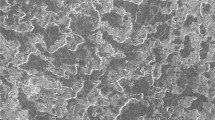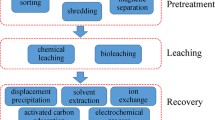Abstract
The aim of this experimental study was to minimize the input of lead and tin ions and fluoboric acid into the waste water from the electroplating line, where the printed circuit boards and other parts of electronic devices are plated with tin-lead alloy. For this purpose, after unloading the parts from the plating tank, they were rinsed in the reclaim tank, from which the aforementioned ions were removed with a reclaim immersed electrochemical module (IEM).
Similar content being viewed by others
REFERENCES
Il'in, V.A., Khimicheskie i elektrokhimicheskie protsessy v proizvodstve pechatnykh plat (Chemical and Electrochemical processes in the Production of Printed Circuit Boards), Moscow: 1994, p. 141.
Vinogradov, S.S., Ekologicheski bezopasnoe gal'vanicheskoe proizvodstvo (Environmentally Safe Plating Process), Kudryavtsev, V.N., Ed., Moscow: Globus, 1998.
Author information
Authors and Affiliations
Additional information
__________
Translated from Zashchita Metallov, Vol. 41, No. 6, 2005, pp. 637–639.
Original Russian Text Copyright © 2005 by Kruglikov, Turaev, Borodulin.
Rights and permissions
About this article
Cite this article
Kruglikov, S.S., Turaev, D.Y. & Borodulin, A.A. Environmentally Safe Plating of Tin-Lead Alloy Coatings. Prot Met 41, 589–591 (2005). https://doi.org/10.1007/s11124-005-0085-1
Received:
Issue Date:
DOI: https://doi.org/10.1007/s11124-005-0085-1




